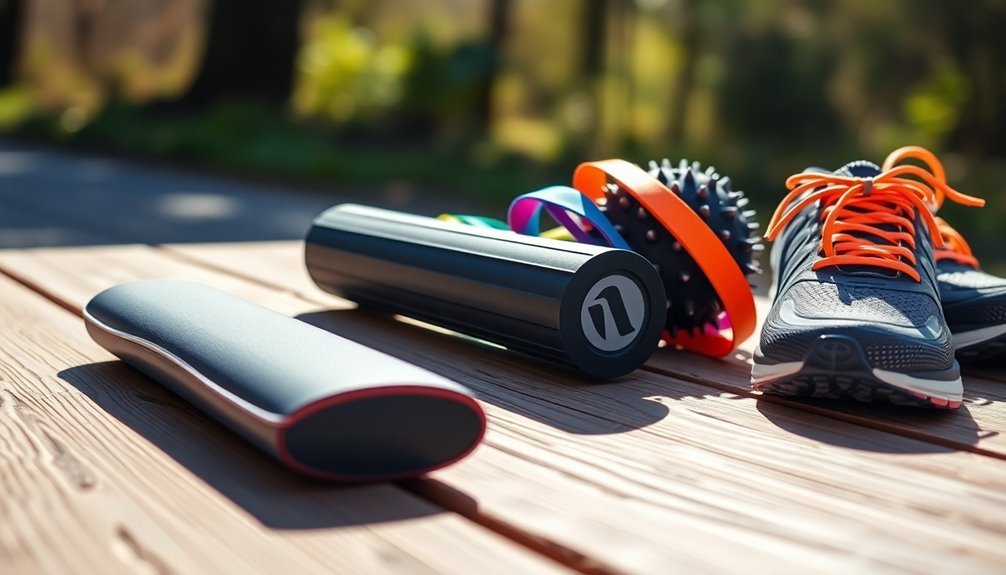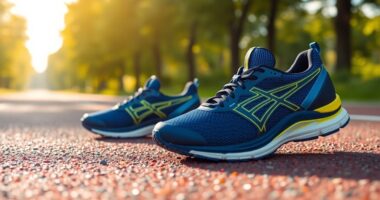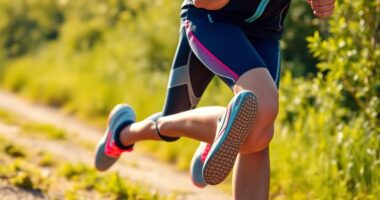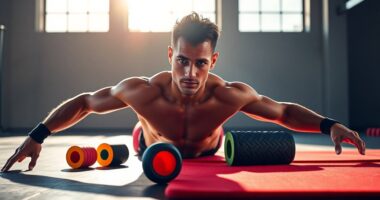As a runner, I've found that using flexibility tools can truly boost my performance and recovery. Tools like the ProStretch Calf Stretcher, OPTP Stretch Out Strap, and foam rollers have become essential in my routine. They help relieve tightness, enhance flexibility, and prevent injuries. I also love incorporating compression garments for circulation benefits. There's a lot to choose from, and I'm excited to share my top picks that could make a difference in your running journey.
Key Takeaways
- ProStretch Original Calf Stretcher provides effective calf stretching, relieving heel pain and improving flexibility for enhanced running performance.
- OPTP The Original Stretch Out Strap features 10 loops for controlled stretching, ideal for runners looking to improve flexibility and prevent injuries.
- Foam rollers enhance muscle recovery by relieving tightness and soreness, increasing range of motion essential for optimal running performance.
- Compression garments promote blood circulation and reduce soreness, aiding recovery after intense running sessions for improved overall performance.
- Massage guns deliver targeted muscle relief, enhancing blood flow and reducing tightness, benefiting runners post-workout for quicker recovery.
ProStretch Original Calf Stretcher and Foot Rocker
If you're struggling with heel pain or tight calves, the ProStretch Original Calf Stretcher and Foot Rocker might just be the solution you need. I've found this device to be incredibly effective for relieving discomfort caused by conditions like plantar fasciitis and Achilles tendonitis. Its unique rocker design allows for a deeper stretch than traditional methods, making it perfect for enhancing flexibility. Plus, it's lightweight and portable, so I can easily use it at the gym or office. With slip-resistant pads, I feel secure while stretching, ensuring I can focus on improving my performance and recovery.
Best For: Individuals experiencing heel pain, tight calves, or conditions such as plantar fasciitis and Achilles tendonitis looking for an effective stretching solution.
Pros:
- Medically proven to provide a deeper and more effective stretch compared to conventional methods.
- Lightweight and portable design makes it easy to use at home, the gym, or the office.
- Slip-resistant pads ensure safety during stretching, enhancing user confidence.
Cons:
- May not accommodate larger shoe sizes beyond 12.
- Requires the use of supportive shoes, which may limit some users.
- Initial discomfort may occur for those not used to deep stretching techniques.
Therapist's Choice® Stretch Strap for Flexibility and Dynamic Stretching
The Therapist's Choice® Stretch Strap is perfect for runners looking to enhance their flexibility and prevent injuries. I love how its all-elastic design allows me to perform effective contract-relax stretches and comfortable static stretches. With durable nylon on one side and stretchable loops on the other, I can target major muscle groups like my hamstrings and hips. The loops give me control, helping me achieve deeper stretches without straining my upper body. Plus, the included manual is a fantastic guide for various stretches, making it easy to incorporate into my routine, whether I'm running, practicing yoga, or just looking to improve my flexibility.
Best For: Athletes, dancers, runners, and anyone looking to improve their flexibility and prevent injuries through effective stretching.
Pros:
- Provides control over stretching for deeper, more effective results.
- Compact and convenient, making it easy to use anywhere.
- Includes a manual with instructions for various stretches, suitable for multiple activities.
Cons:
- May require some practice to master certain stretches.
- Elastic design might not offer the same resistance as non-elastic options for some users.
- Limited color or design options may not appeal to everyone.
Foot and Calf Stretcher Stretching Strap for Plantar Fasciitis
For anyone dealing with plantar fasciitis or related foot issues, the Foot and Calf Stretcher Stretching Strap is a game-changer. I've found it incredibly effective in alleviating pain and improving flexibility. Its durable design, with six loops and an ergonomic cradle, makes stretching comfortable and versatile. You can target your arches, calves, and even hamstrings easily. Plus, it's perfect for athletes and anyone recovering from injuries. While the instructions could be clearer, I've noticed significant relief and increased blood circulation after regular use. It's compact too, so I can take it anywhere. Highly recommend it!
Best For: Individuals suffering from plantar fasciitis, Achilles tendonitis, and athletes seeking to improve flexibility and recover from injuries.
Pros:
- Effective pain relief: Users report significant alleviation of plantar fasciitis pain and improved flexibility.
- Durable and versatile design: The strap features six loops and an ergonomic cradle for targeting various muscle groups comfortably.
- Portable and easy to use: Comes with a handy carrying pouch and an instruction manual, making it simple to use anywhere.
Cons:
- Instructions may be confusing: Some users found the provided instructions unclear or difficult to follow.
- Limited to specific conditions: Primarily designed for foot and calf stretching, which may not address all muscle or joint issues.
- Requires regular use for effectiveness: Users may need to consistently use the strap to see ongoing benefits.
AmazeFan Leg Stretcher for Ballet, Yoga, Dance, and Martial Arts
Designed specifically for dancers, martial artists, and yoga enthusiasts, the AmazeFan Leg Stretcher is a game-changer in enhancing flexibility. Made from high-quality stainless steel, it's sturdy and resistant to rust. The adjustable split device allows me to tailor my stretching levels, making it perfect for my needs. I love how it helps elongate tight muscles, boosts blood circulation, and improves my range of motion, which benefits my daily activities. Plus, it's portable and comes with a storage bag, making it easy to use anywhere. Just remember to warm up and take breaks to prevent strain!
Best For: Dancers, martial artists, and yoga enthusiasts looking to enhance their flexibility and range of motion.
Pros:
- Sturdy and durable design made from high-quality stainless steel.
- Adjustable stretching levels to accommodate various flexibility needs.
- Portable with a storage bag for easy transport and use anywhere.
Cons:
- Some users reported durability issues with the pads.
- Potential risk of the middle bar breaking under excessive stress.
- Requires proper warm-up and precautions to avoid knee injuries.
tchrules Door Leg Stretcher for Flexibility & Stretching
Looking to enhance your leg flexibility and achieve those impressive splits or high kicks? The tchrules Door Leg Stretcher is a game changer! Made from high-quality materials, it's incredibly easy to set up—just place the door anchor over a sturdy doorpost and you're ready to go. This tool improves leg flexibility, balance, and range of motion, making it perfect for runners, dancers, and martial artists. I've noticed significant improvements in my flexibility within weeks. Just be cautious with door hinges to avoid accidents. Overall, it's a durable, effective stretching tool that I highly recommend for anyone serious about flexibility!
Best For: The tchrules Door Leg Stretcher is best for dancers, athletes, and anyone looking to improve their leg flexibility and achieve advanced stretching goals like splits and high kicks.
Pros:
- Effective tool for enhancing leg flexibility, balance, and range of motion.
- Easy to set up and portable, making it convenient for use at home or on the go.
- Made from durable materials, ensuring longevity and safety during use.
Cons:
- Caution needed when using on doors with hinges to avoid accidental openings.
- Some users have reported issues with the strap slipping out of the metal D-ring.
- Initial setup may feel awkward for some users, requiring a bit of adjustment.
Leg Stretcher Strap for Dance and Aerial Yoga
The Leg Stretcher Strap is an excellent choice for anyone aiming to boost their flexibility, especially dancers and aerial yoga enthusiasts. Made from premium nylon fabric, it's soft, sturdy, and hypoallergenic, ensuring comfort during use. The non-elastic design allows for gradual stretches, effectively elongating muscles and improving range of motion. I love how versatile it is—suitable for various exercises like backbends and even postnatal recovery. Plus, it comes with a travel bag and a 60-day warranty, giving me peace of mind. Just make sure you have a solid door for setup, and you're ready to enhance your stretching routine!
Best For: Dancers, aerial yoga practitioners, and anyone looking to improve their flexibility and range of motion.
Pros:
- Made from soft and durable premium nylon fabric that is skin-friendly and hypoallergenic.
- Non-elastic design allows for gradual stretches, reducing the risk of injury and promoting flexibility.
- Comes with a travel bag and a 60-day worry-free warranty for added convenience and peace of mind.
Cons:
- Requires a solid door for setup, which may not be available in all environments.
- Some users report issues with fabric quality and static electricity, affecting their experience.
- Feedback on comfort and construction quality varies, with some users experiencing discomfort.
OPTP The Original Stretch Out Strap for Physical Therapy and Yoga
For runners aiming to enhance their flexibility and prevent injuries, OPTP The Original Stretch Out Strap is an indispensable tool. Since its introduction in 1993, it's become a favorite among physical therapists and trainers. Made in the USA, its durable nylon design withstands heavy use. With 10 loops, I can easily control my stretches, targeting key muscle groups like my legs and back. The strap's versatility allows me to use it for yoga, Pilates, or physical therapy. Plus, it comes with a handy exercise booklet and a video guide, making it easy to incorporate into my routine for maximum recovery.
Best For: Runners, yoga enthusiasts, and anyone seeking to improve flexibility and prevent injuries through effective stretching.
Pros:
- Durable Material: Made of non-elastic woven nylon, ensuring long-lasting use.
- Versatile Usage: Suitable for various activities including yoga, Pilates, and physical therapy.
- Comprehensive Resources: Comes with an exercise booklet and video guide for effective stretching routines.
Cons:
- Limited Stretching Assistance: The strap is unassisted, requiring some skill to use effectively.
- Bulkier Design: May not be as portable as other stretching tools due to its size.
- Price Point: As a specialized product, it may be more expensive than standard straps.
Multifunction Tension Rope Fitness Equipment for Stretching and Training
Runners seeking to enhance their flexibility and overall fitness will find the multifunction tension rope fitness equipment invaluable. Made from eco-friendly materials, this gear features six high-tensile pull ropes, offering superior elasticity for effective workouts targeting arms, legs, and core. Its lightweight design makes it portable, perfect for home, hotels, or even outdoors. I love how I can stretch while lying in bed or do arm exercises seated. Plus, the foam grips guarantee comfort and stability during use. By incorporating this tool, I've improved my range of motion, reduced injury risks, and relieved post-run aches—definitely a game-changer for my routine
Best For: Runners and fitness enthusiasts looking to improve flexibility and strength through portable, versatile exercise equipment.
Pros:
- High tensile strength: Six pull ropes provide superior elasticity for effective full-body workouts.
- Portability: Lightweight design allows for easy use at home, in hotels, or outdoors.
- Comfortable grips: Foam grips ensure stability and comfort during exercises, enhancing user experience.
Cons:
- Durability concerns: Some users may experience issues with rubber tubes becoming unbalanced over time.
- Limited resistance options: The fixed resistance may not cater to users seeking a wider range of resistance levels.
- Learning curve: Beginners may require time to learn how to effectively use the equipment for various exercises.
3 Bar Leg Stretcher – Stainless Steel Split Machine for Yoga, Ballet, Dance and Gymnastics
Designed specifically for athletes and enthusiasts in yoga, ballet, dance, and gymnastics, the 3 Bar Leg Stretcher offers an effective way to enhance flexibility and improve performance. I've found it invaluable for increasing my range of motion while reducing muscle stiffness. The adjustable settings make it easy to tailor the stretch to my body, and the durable stainless steel construction guarantees it'll last. It promotes better circulation, speeding up recovery after intense workouts. Just remember to warm up properly before using it to avoid injury. Overall, it's a fantastic tool that I highly recommend for anyone looking to boost their flexibility.
Best For: Athletes, dancers, and fitness enthusiasts seeking to enhance flexibility and improve their range of motion.
Pros:
- Improves flexibility and range of motion, essential for activities like yoga, ballet, and gymnastics.
- Durable construction with stainless steel ensures long-lasting use.
- Adjustable settings accommodate various body types and stretching needs.
Cons:
- Some users report concerns about the sturdiness of connection points and joints.
- Requires proper warm-up to avoid potential injury during use.
- Novice users may need guidance on stretching techniques to maximize benefits and minimize risks.
Slant Board Calf Stretcher for Physical Therapy (3pcs)
The Slant Board Calf Stretcher is an excellent choice for anyone looking to enhance their flexibility and strength, especially those recovering from lower-leg injuries. I've found it incredibly effective for stretching both the gastrocnemius and soleus muscles, which helps prevent injuries like Achilles tendonitis. Using it for calf raises and heel-elevated squats has improved my performance substantially. Plus, it's lightweight and adjustable, making it easy to use at home or the gym. Just remember to wear shoes for better grip and guarantee the board is on a non-slip surface. It's a must-have for any serious runner
Best For: The Slant Board Calf Stretcher is best for athletes, runners, and individuals recovering from lower-leg injuries seeking to improve flexibility and strength.
Pros:
- Effective Stretching: Targets both the gastrocnemius and soleus muscles for deeper stretches, reducing the risk of injuries.
- Versatile Usage: Can be used for both stretching and strengthening exercises, enhancing performance in various activities.
- Lightweight and Adjustable: Easy to transport and adjust for different angles, making it convenient for home and gym use.
Cons:
- Slippery Surface: The foam can be slippery when using socks, requiring the use of shoes or additional grip enhancements.
- Not Suitable for All: May not be recommended for individuals with chronic knee injuries like arthritis during certain exercises.
- Requires Non-Slip Surface: Must be used on a stable, non-slip surface to prevent accidents while exercising.
Stretching Strap with Door Anchor & Resistance Band for Flexibility Training
For anyone looking to enhance their leg flexibility and range of motion, the Stretching Strap with Door Anchor & Resistance Band is a game changer. I love how versatile it is; it works perfectly as a door leg stretcher and splits trainer. The adjustable loops allow me to gradually improve my flexibility, and the premium materials guarantee safety during my stretches. Plus, it's lightweight and travel-friendly, making it easy to use at home or on the go. With a bonus resistance band and a detailed exercise booklet included, it's an all-in-one solution for anyone aiming to boost their performance and recovery.
Best For: Dancers, gymnasts, cheerleaders, and fitness enthusiasts of all skill levels looking to improve their leg flexibility and overall performance.
Pros:
- Adjustable loops allow for gradual flexibility improvements and safe stretching.
- Lightweight and portable design makes it easy to use at home, in the studio, or while traveling.
- Includes a bonus resistance band and a detailed exercise booklet for a comprehensive training experience.
Cons:
- May require consistent use over time to see significant results in flexibility.
- Some users may find the door anchor challenging to set up initially.
- Limited to flexibility training and may not cater to other fitness goals without additional equipment.
Stretching Strap with Door Anchor for Flexibility Training
Looking to enhance your flexibility and strength? The Stretching Strap with Door Anchor is a game-changer for my routine. It's perfect for achieving deeper stretches and improving my leg flexibility, especially for activities like yoga and dance. I love how easy it is to set up on any sturdy door. The adjustable loops provide comfort and control, letting me focus on my form. Plus, with its portable design, I can take it anywhere. Regular use has noticeably increased my range of motion. If you're serious about flexibility training, this tool is a must-have!
Best For: Individuals looking to enhance their flexibility and strength through stretching for activities like yoga, dance, and gymnastics.
Pros:
- Adjustable loops provide comfort and control during stretches.
- Lightweight and portable design allows for easy transport and use anywhere.
- Proven to improve range of motion and flexibility with regular use.
Cons:
- May require some practice to master the use of the strap and achieve optimal results.
- The door anchor might not fit all door types securely.
- Some users may find the strap less effective if not used consistently.
StrongTek Plastic Calf Stretch Board for Physical Therapy
Runners seeking effective ways to enhance their flexibility will find the StrongTek Plastic Calf Stretch Board particularly beneficial. Its ergonomic design elevates your feet and legs, relieving fatigue and improving posture. With multiple incline settings, you can easily target specific muscles for a deeper stretch, making it perfect for pre- and post-workout routines. The lightweight plastic makes it portable and easy to store, while the textured surface guarantees safety during use. Users rave about its effectiveness, especially for conditions like plantar fasciitis. Plus, with a money-back guarantee, you can try it risk-free and see the benefits for yourself
Best For: Runners and individuals looking to improve flexibility and relieve foot and ankle pain through effective calf stretching. Incorporating calf stretching into your routine can significantly enhance your overall performance and comfort during runs. For those who experience discomfort, selecting the best ankle braces for runners can provide additional support and stability, helping to alleviate pressure on the joints. By combining stretching with the right brace, you can improve your flexibility and reduce the risk of injury, allowing you to enjoy your runs to the fullest.
Pros:
- Ergonomic design enhances posture and relieves fatigue during stretching.
- Adjustable incline settings allow for targeted muscle stretching and gradual progression.
- Lightweight and portable design makes it easy to use at home or in the gym.
Cons:
- Some users may need to hold onto something for balance while using the board.
- The plastic material, while sturdy, may not be as durable as wooden alternatives.
- Limited to calf stretching; may not accommodate other types of stretches or workouts.
Muscle Roller and Body Myofascial Massage Stick for Athletes
Athletes seeking effective ways to enhance their recovery and flexibility will find the Muscle Roller and Body Myofascial Massage Stick invaluable. This tool's designed for myofascial release, helping to eliminate knots and relieve soreness after intense workouts. I love how it improves blood circulation, boosts flexibility, and breaks down soft tissue adhesions. It's versatile enough to target various body parts, from my neck to my calves. Made from durable, high-quality materials, it's easy to use anywhere, allowing me to perform self-myofascial release without needing a therapist. Plus, it comes with a satisfaction guarantee, ensuring I'm always happy with my purchase.
Best For: Athletes and active individuals seeking effective recovery tools for muscle soreness and flexibility enhancement.
Pros:
- Versatile design targets multiple body areas, including neck, back, and legs.
- Durable construction from high-quality materials ensures long-lasting use.
- Easy to use for self-myofascial release, eliminating the need for a therapist.
Cons:
- Heavy for travel, making it less portable for some users.
- May require practice to achieve optimal results for myofascial release techniques.
- Limited cushioning may not be suitable for everyone's comfort preferences.
5 in 1 Foam Roller Set for Deep Muscle Massage and Fitness Exercise
Designed specifically for those who push their physical limits, the 5 in 1 Foam Roller Set is an essential tool for anyone seeking deep muscle relief and enhanced fitness performance. I've found it incredibly effective for easing muscle soreness and improving circulation, especially after long runs. With components like a hollow foam roller, a massage stick, and a massage ball, I can target various muscle groups. It's lightweight and portable, making it easy to take to the gym or even outdoors. Plus, the high-quality materials guarantee durability, so I know it'll last through my intense workouts.
Best For: Athletes, runners, yoga practitioners, and anyone looking to relieve muscle soreness and improve their fitness performance. These individuals often push their bodies to the limit, making it crucial to maintain optimal hydration and nutrient balance. For those looking to enhance their recovery and ensure peak performance, incorporating the best electrolyte supplements for runners can be incredibly beneficial. These supplements help replenish essential minerals lost during intense workouts and support overall endurance, allowing athletes to train harder and recover faster.
Pros:
- High-quality materials ensure durability and resistance to wear.
- Lightweight and portable design allows for easy transportation to any location.
- Versatile components effectively target various muscle groups and alleviate tension.
Cons:
- Some users may find the massage stick too hard for their preference.
- The hollow foam roller may compact in the middle with heavy use.
- Not all users may prefer the firmness of the rollers, as some might desire softer options.
Factors to Consider When Choosing Flexibility Tools for Runners

When I choose flexibility tools for running, I think about several key factors that can really make a difference. Stretching effectiveness, portability, and material durability top my list, but I also consider adjustable and safety features. Let's break down how each of these aspects can impact my flexibility routine.
Stretching Effectiveness
Choosing the right flexibility tools can make a significant difference in your stretching routine as a runner. I've found that effective tools should provide a biomechanically accurate stretch, like those with a rocker design that positions your foot perfectly for targeting lower leg muscles. Isolated movements allow for deeper stretches compared to conventional methods, helping prevent injuries like plantar fasciitis and Achilles tendonitis. It's also important that the tool can stretch and strengthen muscles, ligaments, and tendons. I appreciate adjustable stretching levels and angles, accommodating various flexibility levels and enabling gradual progression. Ultimately, the right tool enhances flexibility and range of motion, improving performance and reducing injury risk through better blood circulation and muscle recovery.
Portability and Convenience
Portability and convenience are key factors I consider in selecting flexibility tools for my running routine. I always look for lightweight options, like the ProStretch Original Calf Stretcher, which I can easily carry anywhere. Compact designs are also a must; tools like the Foot Rocker and Calf Stretcher are quick to set up, whether I'm at home, in the office, or traveling. I appreciate tools that come with storage solutions, such as the Leg Stretcher Strap with its travel bag, making transport a breeze. Versatility is important too; the StrongTek Plastic Calf Stretch Board works well in various settings. Finally, I prefer tools that are easy to install and remove, like the Stretching Strap with Door Anchor, for ultimate convenience.
Material Durability
Selecting the right flexibility tools for my running routine isn't just about how easy they are to carry; material durability plays a big role too. I've learned to prioritize high-quality materials like nylon, stainless steel, or industrial-grade PVC and EVA. These options can withstand regular use without degrading over time. Non-elastic woven nylon is a great choice since it resists wear and tear. I also prefer lightweight yet sturdy materials, such as foam or plastic, which make transporting my tools a breeze. Anti-slip features, like textured surfaces or rubber lips, guarantee stability during my stretches. Plus, I appreciate tools that are easy to clean, like waterproof PVC and EVA, keeping them hygienic and functional for my workouts.
Adjustable Features
When it comes to flexibility tools for runners, adjustable features can make all the difference in your stretching routine. I've found that tools with adjustable settings, like incline levels or heel rest positions, allow me to customize my stretches to target specific muscle groups effectively. This versatility helps me progress in my flexibility while accommodating my individual needs. For instance, moving the heel rest can deepen or lessen the stretch, which is great for varying conditions or preferences. I also appreciate adjustable loops or straps, as they support gradual improvements in my range of motion, reducing injury risks. Plus, adjustable devices fit various body types and shoe sizes, ensuring a comfortable and effective stretch for everyone.
Safety Features
Safety is paramount when choosing flexibility tools for runners. I always look for tools with a non-slip surface or grip, as this helps prevent accidents and maintains stability during use. Adjustable settings are also vital; they accommodate different body types and flexibility levels, reducing the risk of overstretching or injury. Selecting tools made from durable, high-quality materials that can withstand regular use without breaking or losing shape is imperative. I appreciate tools that come with clear instructions and guidelines for proper use, as this avoids misapplication and potential harm. Finally, I consider tools that offer support features, like heel rests or door anchors, to maintain correct positioning and prevent slipping or falling during my stretching routine.
User Experience
Over time, I've learned that user experience plays a crucial role in choosing flexibility tools for runners. When selecting a tool, I pay close attention to user feedback, especially regarding pain relief and flexibility improvements. It's essential that the tool offers adjustable resistance levels, catering to my flexibility needs and comfort. I always guarantee I warm up properly and gradually progress in my stretching exercises to avoid injuries. Additionally, durability and stability matter—I want a tool that feels safe and effective during use. I've found that combining my chosen tool with night splints or arch support orthotics can enhance my treatment, making my overall experience even better. A thoughtful selection can make a significant difference in my performance and recovery.
Versatility of Use
Flexibility is key to a runner's performance, and choosing the right tools can make all the difference. When I'm selecting flexibility tools, I look for those that target multiple muscle groups like my calves, hamstrings, and Achilles tendons. It is vital to opt for tools with adjustable settings or different modes to suit my varying stretching needs and goals. I also prefer tools that accommodate both static and dynamic stretching to enhance my range of motion while minimizing injury risks. Versatility is important; I want tools I can use in different positions, whether standing or seated. Finally, I appreciate tools that serve both prevention and rehabilitation for common running injuries, like plantar fasciitis and shin splints.
Targeted Muscle Groups
Choosing the right flexibility tools means considering which muscle groups to target effectively. As a runner, I know how vital it is to focus on the calf muscles since they're prone to tightness and injuries like Achilles tendonitis. I also make sure to stretch the plantar fascia and foot muscles, as conditions like plantar fasciitis can really hinder performance. Tight hamstrings are another concern; they can lead to lower back pain and affect my running form. I can't forget about the shin area either—tools that stretch it help prevent shin splints. Finally, targeting the ankle and lower leg muscles enhances my range of motion and reduces the risk of strains. Prioritizing these areas keeps me running strong and injury-free.
Frequently Asked Questions
How Often Should I Use Flexibility Tools for Best Results?
I think using flexibility tools about three to four times a week works best for me. I've noticed that consistency is key; it helps me maintain my range of motion and prevent injuries. After workouts, I like to incorporate some stretching with these tools for ideal recovery. Listening to my body is essential, though. If I feel tightness or soreness, I'll add an extra session to really target those areas.
Can Flexibility Tools Prevent Injuries for Runners?
I believe flexibility tools can definitely help prevent injuries for runners. When I incorporate stretching and mobility exercises into my routine, I feel more limber and less prone to strains. It's not just about running; it's about maintaining a balanced body. By using these tools regularly, I've noticed fewer aches and pains post-run. So, I'd say yes, they can play a vital role in keeping us injury-free while we enjoy our runs.
What Is the Ideal Duration for Each Stretch?
Imagine stretching your muscles like a well-tuned rubber band, ready to snap back into action! When I stretch, I aim for about 15 to 30 seconds per stretch. This gives my muscles enough time to relax and lengthen effectively. I've found that holding each stretch longer than that can be counterproductive. It's all about finding balance—quick, effective stretches help me stay limber and ready to tackle my next run.
Are These Tools Suitable for Beginners?
I think these tools are definitely suitable for beginners. When I first started, I found that they helped me understand my body better and improve my flexibility without feeling overwhelmed. They're designed to be user-friendly, so you won't need advanced skills to get started. Plus, you can adjust the intensity based on your comfort level, making them perfect for anyone just beginning their flexibility journey. Don't hesitate to give them a try!
How Do I Clean and Maintain My Flexibility Tools?
Cleaning and maintaining my flexibility tools isn't as challenging as it sounds. I just make it a routine. For foam rollers, I wipe them down with a damp cloth and mild soap after each use. Resistance bands can be washed gently with soap and water, then air-dried. I check for any wear and tear regularly, replacing them if necessary. Keeping everything clean guarantees my tools last longer and work effectively.
Conclusion
In the grand symphony of running, flexibility tools are the gentle conductors guiding your body's performance and recovery. By incorporating these aids into your routine, you're not just stretching; you're painting a masterpiece of movement, ensuring each stride feels like a dance upon the pavement. So, embrace these tools, let them cradle your muscles, and watch as they transform your runs into a harmonious blend of strength and grace. Your body will thank you for the tender care!

























